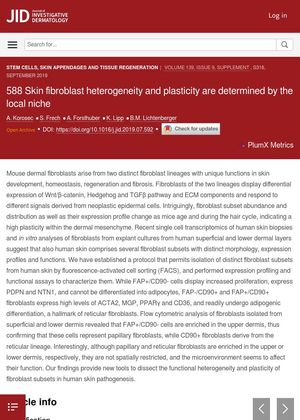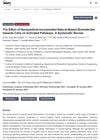Skin Fibroblast Heterogeneity and Plasticity Are Determined by the Local Niche
September 2019
in “
Journal of Investigative Dermatology
”
dermal fibroblasts Wnt/β-catenin Hedgehog pathway TGFβ pathway ECM components neoplastic epidermal cells hair cycle dermal mesenchyme fluorescence-activated cell sorting FACS FAP+/CD90- cells FAP-/CD90+ cells FAP+/CD90+ cells ACTA2 MGP PPARγ CD36 adipogenic differentiation Wnt signaling TGF-beta pathway extracellular matrix FAP positive cells CD90 positive cells adipocyte differentiation

TLDR Mouse skin fibroblasts vary in function and adaptability based on their environment.
In 2019, a study was conducted on mouse dermal fibroblasts, which are derived from two distinct lineages and have unique roles in skin development, homeostasis, regeneration, and fibrosis. These fibroblasts showed differential expression of Wnt/β-catenin, Hedgehog and TGFβ pathway, and ECM components, and responded differently to signals from neoplastic epidermal cells. The study also found that the abundance, distribution, and expression profile of these fibroblast subsets changed with age and during the hair cycle, indicating high plasticity within the dermal mesenchyme. The researchers established a protocol for isolating distinct fibroblast subsets from human skin using fluorescence-activated cell sorting (FACS). They found that FAP+/CD90- cells, which are enriched in the upper dermis, showed increased proliferation and could not be differentiated into adipocytes, while FAP-/CD90+ and FAP+/CD90+ fibroblasts, which are derived from the reticular lineage, expressed high levels of ACTA2, MGP, PPARγ and CD36, and could readily undergo adipogenic differentiation. The study concluded that the microenvironment seems to affect the function of these fibroblasts, providing new tools to understand the functional heterogeneity and plasticity of fibroblast subsets in human skin pathogenesis.


